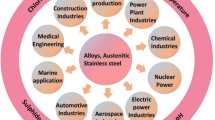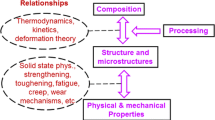Abstract
Investigation of localized corrosion in 7075 aluminum alloy plate shows that the mechanism of corrosion can be rationalized on the basis of potentiokinetic anodic polarization behavior. 7075 alloy in cold water quenched W temper has been shown to be susceptible to both pitting and intergranular corrosion. Aging to peak strength condition (T651 temper) increases the susceptibility to intergranular corrosion. The preferential anodic path is presumed to be solute enrichment (Zn and Mg) in the vicinity of grain boundaries. This is substantiated by the observation of two distinct pitting potentials in the anodic polarization curve for the T651 temper. Overaging to the T7351 temper decreases susceptibility, both by the reduction in the difference between the two pitting potentials and by the reduction in the amount of solute atoms segregated. Metallographic cross-sections of potentiostatically polarized specimens substantiate the proposed mechanism.
Similar content being viewed by others
References
J. R. Galvele and S. M. de De Micheli:Corrosion Sci., 1970, vol. 10, p. 795.
D. E. Davies, J. P. Dennison, and M. L. Mehta:International Conf. on Localized Corrosion, R. W. Staehle,et al, eds., pp. 608–13, National Association of Corrosion Engineers, Houston, TX, 1974.
P. Doig, P. E. J. Flewitt, and J. W. Edington:Corrosion, 1977, vol.33, no. 6, p. 217.
D. O. Sprowls and R. H. Brown:International Conference on Fundamental Aspects of Stress-Corrosion Cracking, R. W. Stahle,et al, eds., pp. 466–512, National Association of Corrosion Engineers, Houston, Texas, 1969.
K. Nisancioglu and H. Holtan:Corrosion Sci., 1978, vol. 18, p.835.
I. L. Muller and J. R. Galvele:Corrosion Sci., 1977, vol. 17, p. 995.
D. O. Sprowls and B. W. Lifka:ASTM STP 516, p. 120, ASTM, Philadelphia, PA, 1972.
G. C. English, W. King, and E. H. Hollingsworth: Bureau of Naval Weapons Contract #W64-0170C, 1964.
A. H. Roebuck and J. V. Luhan:Corrosion, 1967, vol. 23, no. 9, p.269.
S. C. Byrne: Alcoa Laboratories, Alcoa Center, PA, Unpublished Research, 1972.
G. M. Ugianski: PhD. Dissertation, The Ohio State University, Columbus, OH, 1976.
H. Böhni and H. H. Uhlig:J. Electrochem. Soc., 1969, vol. 116, p. 906.
I. L. Muller and J. R. Galvele:Corrosion Science, 1977, vol. 17, p.179.
D. Adenis and A. Gilhaudis:Mem. Sci. Rev. Met., 1967, vol. 64, no. 10, p. 0.
S. Maitra and H. G. Paris: Alcoa Laboratories, Alcoa Center, PA, Unpublished Research, 1979.
P. Doig and J. W. Edington:Corrosion, 1975 vol. 31, no. 10, p. 347.
J. A. S. Green, R. K. Viswanadham, T S. Sun, and W. G. Montague: Martin Marietta Corporation, Baltimore, Md., Technical Report to ONR, 1976 November.
Author information
Authors and Affiliations
Rights and permissions
About this article
Cite this article
Maitra, S., English, G.C. Mechanism of localized corrosion of 7075 alloy plate. Metall Trans A 12, 535–541 (1981). https://doi.org/10.1007/BF02648553
Received:
Issue Date:
DOI: https://doi.org/10.1007/BF02648553




